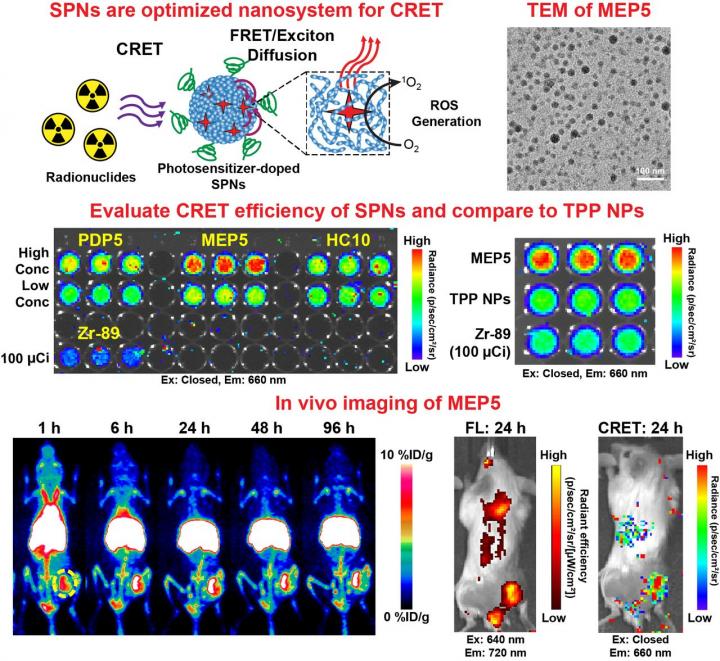
Credit: Image created by ZT Rosenkrans, et al. University of Wisconsin-Madison, Madison, WI.
Reston, VA (Embargoed until 12:30 p.m. EDT, Monday, June 14, 2021) – Researchers have successfully developed a novel cancer treatment approach that utilizes Cerenkov radiation energy to target and destroy cancer cells more effectively. The approach uses light from decaying radiopharmaceuticals, known as Cerenkov luminescence, as an energy source to activate semiconducting polymer nanoparticles that kill cancer cells. This research was presented at the Society of Nuclear Medicine and Molecular Imaging’s 2021 Virtual Annual Meeting.
Over the past several decades, many studies have been conducted on photodynamic therapy, which uses an external light source to activate nanomaterials for cancer therapy. This therapy, however, is limited by the ability of external light to penetrate tissues. As Cerenkov luminescence is spontaneously produced from certain radiopharmaceuticals as they decay in the body, it has recently been proposed as an internal energy source for cancer therapy.
While Cerenkov luminescence is advantageous because it is a light source produced inside of the body, the light source is generally very weak. “The good news is that the light source can be amplified with semiconducting polymers, which greatly increases its potential to target and destroy cancer cells,” said Zachary Rosenkrans, graduate research assistant at University of Wisconsin-Madison in Madison, Wisconsin. “In our study we aimed to determine how to best utilize radiopharmaceuticals and nanoparticles to create the ideal cancer theranostics nanosystem.”
Researchers found that semiconducting polymer nanoparticles optimized with photosensitizers dramatically intensified Cerenkov luminescence to kill cancer cells. Positron emission tomography and optical imaging studies also clearly visualized tumor uptake of these optimized semiconducting polymer nanoparticles. This approach was found to have excellent potential as a cancer theranostics nanosystem without any tissue penetration limits.
“This work is an important step toward translating nanomaterials that are activated by light, using radiopharmaceuticals as an activation source. The basic concept, using semiconducting polymers to harness and amplify light produced from radiopharmaceuticals, is also very exciting and could have many interesting applications in the future,” Rosenkrans noted.
Abstract 71. “Semiconducting polymers enhance Cerenkov radiation energy transfer for multimodal cancer theranostics,” Zachary Rosenkrans, Dalong NI, Kaelyn Becker, Eduardo Aluicio-Sarduy, Jonathan Engle, and Weibo Cai, University of Wisconsin-Madison, Madison, Wisconsin.
###
All 2021 SNMMI Annual Meeting abstracts can be found online at https:/
About the Society of Nuclear Medicine and Molecular Imaging
The Society of Nuclear Medicine and Molecular Imaging (SNMMI) is an international scientific and medical organization dedicated to advancing nuclear medicine and molecular imaging, vital elements of precision medicine that allow diagnosis and treatment to be tailored to individual patients in order to achieve the best possible outcomes.
SNMMI’s members set the standard for molecular imaging and nuclear medicine practice by creating guidelines, sharing information through journals and meetings and leading advocacy on key issues that affect molecular imaging and therapy research and practice. For more information, visit http://www.
Media Contact
Rebecca Maxey
[email protected]



